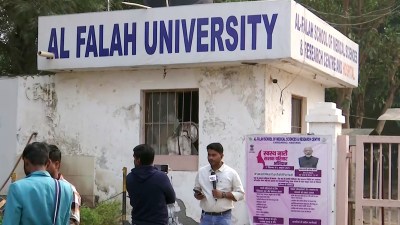Supreme Court floats idea of ‘Project GIB’: What is this endangered bird
The Supreme Court has asked if a 'Project GIB' could be launched to protect the endangered bird Great Indian Bustard. What is this bird, and why is it endangered? What conservation efforts are underway?
 This Great Indian Bustard is found mainly in Rajasthan and Gujarat. (File Photo)
This Great Indian Bustard is found mainly in Rajasthan and Gujarat. (File Photo)Hearing a plea to protect the endangered bird Great Indian Bustard (GIB), the Supreme Court Wednesday asked if a ‘Project GIB’, on the lines of ‘Project Tiger’, could be launched.
“We had that Project Tiger, is it not possible to have some mechanism to bring focus on GIB like having ‘Project Great Indian Bustard’,” the bench of CJI DY Chandrachud, Justice A S Bopanna and Justice V Ramasubramanian said, as reported by PTI.
What is the Great Indian Bustard?
This large bird, found mainly in Rajasthan and Gujarat, has been categorised as critically endangered by the International Union for Conservation of Nature (IUCN).
While the GIBs’ historic range included much of the Indian sub-continent, it has now shrunk to just 10 per cent of that. Among the heaviest birds with flight, GIBs prefer grasslands as their habitats. The terrestrial birds spend most of their time on the ground, feeding on insects, lizards, grass seeds, etc. GIBs are considered the flagship bird species of grassland and hence barometers of the health of grassland ecosystems.
Why is the Great Indian Bustard endangered?
Among the biggest threats to the GIBs are overhead power transmission lines. Due to their poor frontal vision, the birds can’t spot the power lines from a distance, and are too heavy to change course when close. Thus, they collide with the cables and die.
According to the Wildlife Institute of India (WII), in Rajasthan, 18 GIBs die every year after colliding with overhead power lines.
Great Indian Bustard: Conservation efforts
The Supreme Court in April 2021 ordered that all overhead power transmission lines in core and potential GIB habitats in Rajasthan and Gujarat should be made underground.
During Wednesday’s hearing, the court sought reports from the chief secretaries of Rajasthan and Gujarat in six weeks on installation of bird diverters (reflector-like structures strung on power cables) in priority areas. It also asked them to assess the total length of transmission lines that need to go underground in the two states.
Also, in 2015, the Centre had launched the GIB species recovery programme. Under this, the WII and Rajasthan forest department jointly set up breeding centres where GIB eggs harvested from the wild were incubated artificially.



- 01
- 02
- 03
- 04
- 05


































